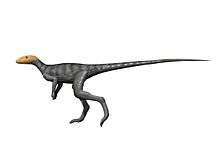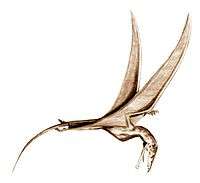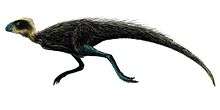Marasuchus
| Marasuchus Temporal range: Late Triassic, 236–234 Ma | |
|---|---|
| | |
| Restored skeleton | |
| Scientific classification | |
| Kingdom: | Animalia |
| Phylum: | Chordata |
| Class: | Reptilia |
| Clade: | Dinosauriformes |
| Genus: | †Marasuchus Sereno & Arcucci, 1994 |
| Species: | †M. lilloensis |
| Binomial name | |
| Marasuchus lilloensis (Romer, 1972 [originally Lagosuchus]) | |
| Synonyms | |
| |
Marasuchus (meaning "Mara crocodile"[1]) is a genus of basal dinosauriform archosaur which lived during the late Triassic in what is now La Rioja Province, Argentina.
Description

Marasuchus was lightly built and small, it had a length of 30–40 cm (1.0–1.3 ft), height of 10 cm (0.3 ft) and weight of 2–5 kilograms (4.4–11.0 lb).[2][3] It was bipedal, walking with an upright (parasagittal) gait, like that of modern mammals and birds.[3]
One of the diagnostic features of dinosaurs, a hole in the hip socket (acetabulum) of the pelvis for the femur (thighbone), is absent in Marasuchus; however, it possessed characteristics, such as an elongate pubis and the presence of an anterior trochanter on the femur, similar to those found in dinosaurs. The presence of these characteristics in Marasuchus shows that some of the features limited to dinosaurs and their close relatives had begun to evolve in the Middle Triassic prior to the formal origin of dinosaurs in the Late Triassic.[3]
Classification

Until 2003 Marasuchus was thought to be one of the closest relatives of the dinosaurs. At present it has been supplanted by other dinosauromorphs such as Silesaurus. Nonetheless, Marasuchus remains an important animal for understanding the origin and evolution of dinosaur characteristics.[3] Cladogram simplified after Nesbitt (2011):
| |
| |||||||||||||||||||||||||||||||||
| |
Discovery and history
Alfred Romer first discovered fossils of the species in the 1960s in the Los Chañares Formation of the Ischigulasto-Villa Unión Basin in northwestern Argentina, all parts of the reptile’s skeletal anatomy are known from fossils except for the skull and lower jaw.[2][3] The formation was dated as being 234 to 236 million years old.[4]
Lagosuchus
Two species have been named, L. talampayensis and L. lilloensis. The genus (Lagosuchus) and type species (L. talampayensis) are regarded as nomina dubia. The species Marasuchus lilloensis was originally described as a second species of Lagosuchus, L. lilloensis. However, in a restudy of Lagosuchus by Sereno and Arcucci (1994), the authors concluded that the original (type) specimen was too poorly preserved to allow any further specimens to be assigned to the genus. They also noted that the L. lilloensis specimen had limb proportions different from the type species. On this basis, they assigned L. lilloensis to a new genus, Marasuchus.[5]
References
- ↑ "Marasuchus". Prehistoric Wildlife. Retrieved 31 March 2016.
- 1 2 Benton, Michael; Brusatte, Steve (25 October 2012). Dinosaurs. UK: Hachette. p. 24. ISBN 1780875738. Retrieved 31 March 2016.
- 1 2 3 4 5 Rafferty, John P, ed. (1 April 2010). The Mesozoic Era: Age of Dinosaurs. Britannica Educational Publishing. p. 126. ISBN 1615301933. Retrieved 31 March 2016.
- ↑ Claudia A. Marsicano, Randall B. Irmis, Adriana C. Mancuso, Roland Mundil and Farid Chemale (2016). "The precise temporal calibration of dinosaur origins". Proceedings of the National Academy of Sciences of the United States of America. 113 (3): 509–513. doi:10.1073/pnas.1512541112.
- ↑ Sereno, Paul C. and Arcucci, Andrea B. (1994). "Dinosaurian precursors from the Middle Triassic of Argentina: Marasuchus lilloensis gen. nov." Journal of Vertebrate Paleontology 14: 53-73 Chicago, IL Abstract



